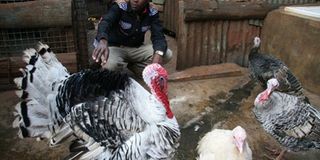How to keep your turkeys happier

Turkeys can be reared in two ways, free-range or intensive system. FILE PHOTO | JENNIFER MUIRURI
What you need to know:
- The free range system is the most suitable for the average smallholder farmer because it is cheaper in terms of investment and management.
- The greatest disadvantage in the free range system is increased parasite (worms and mites) susceptibility and predators.
In the last issue, we talked about why you should consider keeping turkeys. Many readers showed interest in the birds.
Today we offer you tips on how to manage turkeys.
Turkeys can be reared in two ways, free-range or intensive system.
The free range system is the most suitable for the average smallholder farmer because it is cheaper in terms of investment and management.
Turkeys are aggressive scavengers and, therefore, would thrive in free range rearing systems. It is recommended that one should rear 60 birds on quarter an acre.
The farmer is required to fence the area and construct a night shelter at the rate of 2.5 to 3.5 square foot per bird.
One should also create paddocks for rotational purposes as well as disease prevention.
The greatest disadvantage in the free range system is increased parasite (worms and mites) susceptibility and predators.
It is, therefore, necessary to regularly de-worm and dip the birds.
In intensive farming system, heavy investment is required. This mainly goes into the construction of shelters, watering systems, feeding structures and feeds. The shelters should be well-ventilated, water and predator-proof.
This system also requires intensive care and management thus more human labour is required, which means additional expenses.
Litter/bedding (sawdust) lining the houses should be changed regularly to prevent the spread of diseases.
The houses should be regularly fumigated and disinfected. This system leads to increased productivity and reduces disease-incidence, especially worms.
FEEDING
The birds feed on commercial mash and pellets, which are readily available in agrovets. However, inclusion of greens in the diet is highly recommended. For the greens, farmers can use lettuce, spinach or sukuma wiki.
Farmers can also invest in hydroponic farming for supply of green matter. Use of hydroponic fodder is cost-effective as compared to commercial feeds. It is also important to supplement the diet with calcium to help make the legs stronger.
Clean water should be provided throughout the day. The feeders and drinkers should be cleaned daily and disinfected.
OTHER ROUTINE PRACTICES
De-beaking: This prevents cannibalism and feather pecking. Debeaking is done when the poults are between two and five weeks old.
A farmer can engage a veterinary officer or use traditional methods like hot metal blade.
De-toeing: This is done mainly on male poults three days after hatching. Detoeing prevents cannibalism which commonly occurs when the birds are kept under stressful conditions.
De-snooding: It encompasses the removal of the red snoods or dew bills (the fleshy extension found near the base of the neck).
This is necessary as the snood is often pecked thus resulting in head wounds. The excision of the snoods should be undertaken by trained personnel at three weeks of age.
Handling turkeys: One should pick the birds by the legs but this is often discouraged. Young poults should be picked from behind and tucked under the arm, with the legs tightly secured by the other hand.
Dr Muchunguh is a livestock expert




